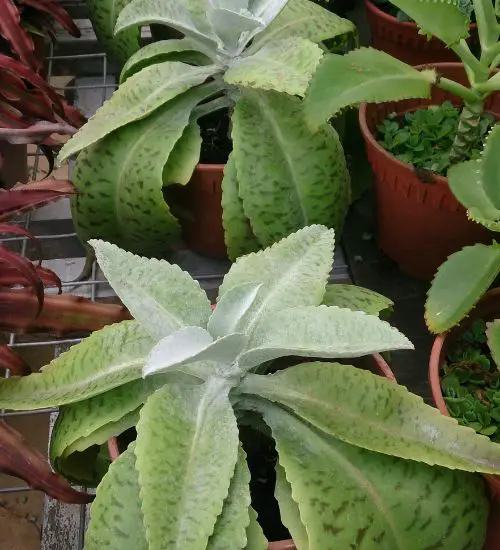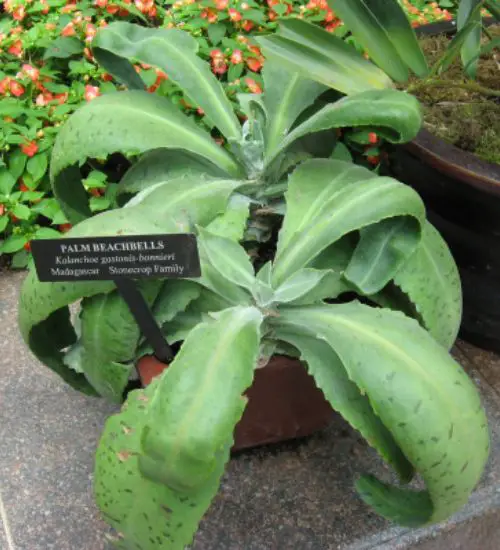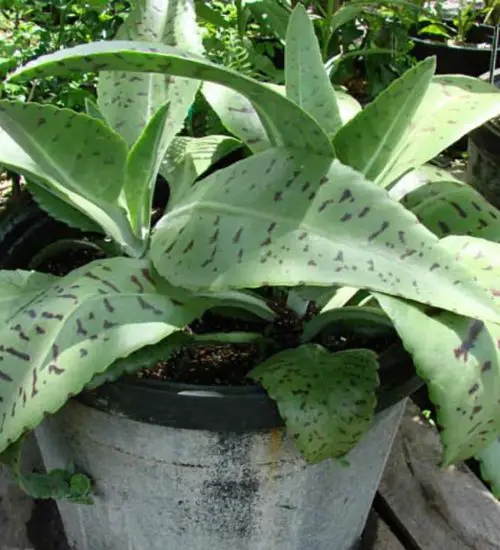Sun: full sun to partial shade
Water: Typical water needs for a succulent
Temperature: Zone 10a from 30° F to 35° F (-1.1 ° C to 1.7° C) to Zone 11b from 45° F to 50° F (7.2° C to 10° C)
Winter Survival: Not cold hardy
Propagation: cuttings
Flower: in the summer
Flower Type: Yellow-Green, salmon colored
Toxic: Toxic to humans and animals
Dormant: summer
Space Requirement: Indoors & Outdoors
Common Problems: pests
Where to buy Kalanchoe gastonis-bonnieri (tropical)?
Basc Care for Kalanchoe gastonis-bonnieri (tropical)
Watering
Regular watering period should be every 2 weeks
You can water your succulent more than often in extreme conditions but make sure that the soil is completely dry before watering your succulent again.
Fertilizing
Only feed this succulent during its active growing seasons which means winter. Use the right fertilizer applied in the right amounts. Applying half-strength balanced fertilizer every month or so is recommended for optimal results.
Do not fertilize during summer as the plant is dormant.
Sun & Location Requirements for "palm beachbells, donkey ear plants"
Kalanchoe gastonis-bonnieri (tropical) does best when placed in an area that receives full sun to partial shade throughout the day. This variety of succulents can tolerate direct sunlight for short periods, but if the temperatures get too high or the light is too intense it may be beneficial to find a shadier spot.
As per this succulent profile, it is only able to stay healthy when the environment temperature is above the range of zone 10a from 30° F to 35° F (-1.1 ° C to 1.7° C).
In order to ensure that Kalanchoe gastonis-bonnieri (tropical) survives the winter, insulation and drainage are essential. A layer of mulch or gravel around the plant can help keep the roots warm during cold temperatures. Furthermore, avoiding exposure to wind and sun can reduce the risk of frost damage and promote longevity for your succulent.
Any succulents in the group will need a medium space to grow. You can place your pot at your table or window. Since this plant needs more space than mini succulents, you should consider do not plant them together with other succulents/plants.
Kalanchoe gastonis-bonnieri (tropical) also benefits from some indirect light throughout the day as well, so make sure you give it enough space to soak up light without becoming too exposed to heat.
Propagation
One way to propagate Kalanchoe gastonis-bonnieri (tropical) is by cutting
Toxicity

Kalanchoe gastonis-bonnieri (tropical) is a highly toxic plant and should be handled with extreme caution. Ingestion can cause nausea, vomiting and other serious health issues in both humans and animals alike.
Pests and Diseases
Kalanchoe gastonis-bonnieri (tropical) can be affected common pests and diseases like most of the other succulents such as aphids and mealybugs.
If you do spot any of pest signs, you can treat your succulent using below methods.
- Aphids: quarantine, clean infected plants, soapy water.
- Mealybugs: quarantine, clean infected plants, soapy water.
Besides that, to prevent serious health issues from happening, keep your succulent in a well-ventilated area and check it regularly for any signs of pests or health problems.


